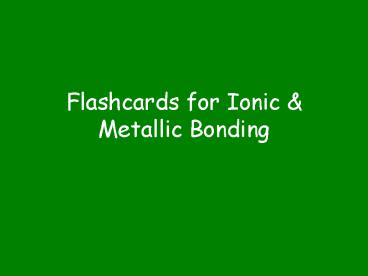Flashcards for Ionic - PowerPoint PPT Presentation
Title:
Flashcards for Ionic
Description:
Flashcards for Ionic & Metallic Bonding What particle is transferred in ionic bonding? Electron How do you identify an ionic formula? Metal + Nonmetal How do you ... – PowerPoint PPT presentation
Number of Views:100
Avg rating:3.0/5.0
Title: Flashcards for Ionic
1
Flashcards for Ionic Metallic Bonding
2
What particle is transferred in ionic bonding?
- Electron
3
How do you identify an ionic formula?
- Metal Nonmetal
4
How do you identify a covalent formula?
- All Nonmetals
5
What do metals do?
- Metals lose electrons form positive ions.
6
What do nonmetals do?
- Nonmetals gain electrons form negative ions.
7
What are the properties of metals?
- Luster
- Good conductors of heat electricity
- Malleable ductile
- Low ionization energy low electronegativity
- High mp, high bp low vapor pressure
8
Why do atoms form bonds?
- To get the same electron configuration as the
nearest noble gas.
9
What is a chemical bond?
- Force of attraction that holds 2 atoms together.
10
What are the properties of ionic compounds?
- Hard, brittle
- High melting point, high boiling point
- Low vapor pressure
- Poor conductors of heat
- Solids do not conduct electricity at all
- Melts solutions do conduct a current
- Ions in solution react quickly
11
What is the structure of ionic compounds?
- Crystal lattice lattice points are positive
negative ions.
12
Empirical Formula
- Subscripts in chemical formula have smallest
whole number ratio
13
Empirical Formula
- Ionic compounds only have empirical formulas.
14
Crystal lattice
- Regular, repeating pattern in 3 dimensions.
15
Compounds are electrically
- Neutral.
16
Molecular Formula
- Gives exact composition of molecule.
17
What is the structure of metals.
- Crystal lattice all lattice points are positive
ions.
18
Delocalized electrons
- Valence electrons in metals are free to roam
throughout the metal.
19
Sea of mobile electrons
- Phrase used to describe valence electrons in
metallic bonding.
20
Subscripts in chemical formulas
- Microscopic scale give atomic ratios
- Macroscopic scale give mole ratios
21
Lewis Dot Structures for Ionic Compounds
- Have square brackets and charges. Charges add
up to 0. Positive ion has no dots. Negative ion
has 8 dots.
22
Group 1 metals form
- 1 ions
23
Group 2 metals form
- 2 ions
24
Group 16 nonmetals form
- -2 ions
25
Group 17 nonmetals form
- -1 ions
26
Group 18 nonmetals form
- They dont form ions. There the noble gases!
27
NaCl
- Binary Ionic Cmpd.
- Na has only 1 oxidation state.
- Sodium Chloride
28
FeCl2
- Binary Ionic Cmpd.
- Fe has 2 possible oxidation states.
- Iron (II) chloride
29
Names
- Words Roman Numerals
30
Formulas
- Symbols Subscripts
31
Fe(NO3)3
- Contains a polyatomic.
- Fe has 2 possible oxidation states.
- Iron (III) Nitrate



























![[PDF] Student Workbook for Modern Dental Assisting with Flashcards Full PowerPoint PPT Presentation](https://s3.amazonaws.com/images.powershow.com/10101140.th0.jpg?_=20240816097)
![[DOWNLOAD]PDF GMAT Flashcards PowerPoint PPT Presentation](https://s3.amazonaws.com/images.powershow.com/10101613.th0.jpg?_=20240819045)
![[DOWNLOAD]PDF GMAT Flashcards PowerPoint PPT Presentation](https://s3.amazonaws.com/images.powershow.com/10103782.th0.jpg?_=20240821011)
![[DOWNLOAD]PDF GMAT Flashcards PowerPoint PPT Presentation](https://s3.amazonaws.com/images.powershow.com/10121602.th0.jpg?_=20240905092)
